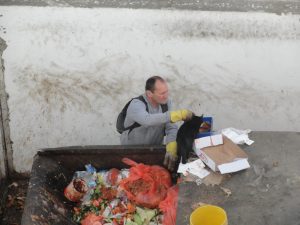
Increased levels of male breast cancer and early onset puberty are consequence of water pollution in Israel.
The 52nd Conference of the Israel Geographical Association conducted the last week of December at Tel Aviv University dealt with developments affecting Israel, the Middle East and the planet as a whole. Geography, a discipline that is multi-varied in the subjects it addresses, is deeply relevant to the issues that environmentalists find most compelling.
A particularly interesting – and worrying –presentation was made by Dr. Dror Avisar, head of the Hydrochemistry Lab in the Department of Geography and Human Environment at Tel Aviv University. The lab focuses on micro-contaminants in groundwater. Avisar’s presentation at the geography conference dealt with the impact of medicines remaining from human and animal use on Israel’s water stocks. This contamination is much more widespread, enduring and harmful than I was aware of.
For example, an estimated ninety percent of antibiotics consumed to combat or prevent disease is excreted back into the water supply. Additionally, discarded antibiotics and other drugs are dumped (from hospitals or manufacturing facilities) and return to the hydrological system. Even sophisticated water treatment systems have difficulty filtering out these contaminants, which also include considerable amounts of painkillers, psychotropic medications and hormones.
These micro-contaminants present multiple problems. Their biodegradability takes longer than previously believed and the reactivity of their components is high.
Antibiotic-resistant bacteria is already a concern for infectious disease physicians and epidemiologists. Similarly, the buildup of tolerance to pain meds and psychiatric ones could also conceivably be a consequence of the presence of these substances in water and the soils they irrigate or infiltrate.
So, too, the presence in water and soil of hormones and endocrine-disrupting chemicals, even in micro-doses to small to be screened, has already been linked to the premature onset of puberty in the early elementary school grades, loss of sperm count and motility, and an increased incidence of male breast cancer, and allergies has also been reported. Examples of affected settlements in Israel were presented by Avisar.
Changes in Israel’s Rural Space
Other presentations dealt with changes in Israel’s rural space. Among these are the spatial transformations of many kibbutzim, which have converted lands from agricultural or industrial purposes to expanded residential communities for nonmembers.
The latter are interested in commuting to work in urban areas from residences in rural space, where a higher quality of life and direct contact with the natural environment are priorities. Further studies on the impact these new ex-urban areas will have on such issues as environmental quality, the preservation of open spaces and Israeli society as a whole, will be needed.
Also pertaining to Israel’s rural sector, which has been wracked by changes in the traditional support system that the authorities once provided to agricultural producers but which have been profoundly affected by the free market approach and generally dismissive policies of recent governments, was a paper by Giora Ben-Dror dealing with the moshav.
The moshav, a cooperative (in contrast to the traditional kibbutz, a communal village), has been troubled by some of the same difficulties the kibbutz has faced since the 1990s. Interestingly, while its historical economy has been profoundly affected, many moshavim remain a social and spatial organization that continues to adapt to changing conditions.
The conference began with an internal debate among geographers concerning the increasing quantification of the social sciences, with measurement and statistical data, analysis and simulation being placed at the service of planning and other professions. The “positivists’ are countered by other geographers, who believe the discipline should be focused on theory and social critique and historical, case and descriptive studies.
The truth is, that both camps in the geographical community have been coexisting for years, and the healthy debate is more academic than operational: Practitioners of both quantitative and qualitative approaches are alive in Israeli and international departments of geography and elsewhere and neither are in danger of perishing.
Dr. Yosef Gotlieb, a geographer, blogs at “Issues of the Day” on his website, www.ysgotlieb.net. He is the author of Rise, A Novel of Contemporary Israel.
image via notionscapital




Comments are closed.